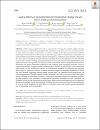Legacy effects of experimental environmental change on soil micro-arthropod communities
| المؤلف | Roos, Ruben Erik |
| المؤلف | Birkemoe, Tone |
| المؤلف | Asplund, Johan |
| المؤلف | Ľuptáčik, Peter |
| المؤلف | Raschmanová, Natália |
| المؤلف | Alatalo, Juha M. |
| المؤلف | Olsen, Siri Lie |
| المؤلف | Klanderud, Kari |
| تاريخ الإتاحة | 2020-08-11T05:55:24Z |
| تاريخ النشر | 2020-02-01 |
| اسم المنشور | Ecosphere |
| المعرّف | http://dx.doi.org/10.1002/ecs2.3030 |
| الاقتباس | Roos, R. E., Birkemoe, T., Asplund, J., Ľuptáčik, P., Raschmanová, N., Alatalo, J. M., ... & Klanderud, K. (2020). Legacy effects of experimental environmental change on soil micro‐arthropod communities. Ecosphere, 11(2), e03030. |
| الملخص | © 2020 The Authors. Global change experiments such as experimental warming and nutrient addition strongly affect the structure and functioning of high latitude and altitude ecosystems. However, it is often unknown to what extend such effects are permanent or whether changes persist after environmental conditions return to pre-treatment levels. In this study, we assess the legacy effects of temperature manipulation and nutrient addition experiments on alpine soil micro-arthropod (i.e., Collembola and Oribatida) communities nine years after the treatments were discontinued. Treatment effects on the vegetation were still detectable six years after cessation, although grazing increased the recovery rate. Because micro-arthropods are often closely associated with vegetation, we expected to find that treatment effects on Collembola and Oribatida abundance and species composition persisted to date, reflecting plant community dynamics. Also, we expected large-bodied, drought-resistant Collembola species that live on top of the soil to show less strong legacy effects. We did not find legacy effects of environmental treatments on Collembola and Mesostigmata in terms of abundance. However, we found persistent changes in community composition of Collembola and Oribatida, suggesting treatment effects persist to date. The generalist Folsomia quadrioculata was the most responsive Collembola species to initial treatments, most likely due to its variable life-history strategy. Although its abundance recovered, F. quadrioculata remained dominant in Collembola communities after cessation of the treatments. Grazing affected community composition of both Collembola and Oribatida, but we did not find grazing to reduce legacy effects on micro-arthropod as it did for vegetation. We therefore conclude that the environmental treatments had only temporary effects on micro-arthropods in terms of overall abundance, but that effects on individual species and therefore species composition may be long-lasting and less predictable. |
| راعي المشروع | The study was designed by Johan Asplund, Juha M. Alatalo, and Kari Klanderud. Field work was performed by Ruben Erik Roos, Johan Asplund, Kari Klanderud, and Tone Birkemoe. Peter Ľuptáčik and Natália Raschmanová identified soil micro‐arthropods for 2016. Statistical analyses were performed by Ruben Erik Roos and Siri Lie Olsen. All co‐authors contributed to manuscript revisions and agree with the final version. This study was funded by Carl Tryggers stiftelse för vetenskaplig forskning through a grant to Juha M. Alatalo and a grant from the Research Council of Norway (249902) to Johan Asplund. We thank Sigmund Hågvar for sharing his original data, comments and feedback, Hans Cornelissen and Stef Bokhorst for useful discussions, and Matty Berg for sharing data from his personal Collembola database. Mari Steinert, Ross Wetherbee, Mahdieh Tourani, and Richard Bischof were of great help for discussions on the statistical analyses. We thank the Finse Alpine Research Center and Erika Leslie for hospitality during fieldwork and Kristel van Zuijlen for assistance in the field. |
| اللغة | en |
| الناشر | wiley |
| الموضوع | Acari alpine ecology Collembola community recovery ecological resilience ecosystem recovery experimental warming herbivory nutrient addition Oribatida |
| النوع | Article |
| رقم العدد | 2 |
| رقم المجلد | 11 |
| ESSN | 2150-8925 |
الملفات في هذه التسجيلة
هذه التسجيلة تظهر في المجموعات التالية
-
مجموعة علوم الأرض [217 items ]


